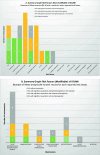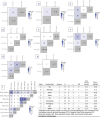Which factors are associated with acquired weakness in the ICU? An overview of systematic reviews and meta-analyses
- PMID: 39232808
- PMCID: PMC11375885
- DOI: 10.1186/s40560-024-00744-0
Which factors are associated with acquired weakness in the ICU? An overview of systematic reviews and meta-analyses
Abstract
Rationale: Intensive care unit-acquired weakness (ICUAW) is common in critically ill patients, characterized by muscle weakness and physical function loss. Determining risk factors for ICUAW poses challenges due to variations in assessment methods and limited generalizability of results from specific populations, the existing literature on these risk factors lacks a clear and comprehensive synthesis.
Objective: This overview aimed to synthesize risk factors for ICUAW, categorizing its modifiable and nonmodifiable factors.
Methods: An overview of systematic reviews was conducted. Six relevant databases were searched for systematic reviews. Two pairs of reviewers selected reviews following predefined criteria, where bias was evaluated. Results were qualitatively summarized and an overlap analysis was performed for meta-analyses.
Results: Eighteen systematic reviews were included, comprising 24 risk factors for ICUAW. Meta-analyses were performed for 15 factors, while remaining reviews provided qualitative syntheses. Twelve reviews had low risk of bias, 4 reviews were unclear, and 2 reviews exhibited high risk of bias. The extent of overlap ranged from 0 to 23% for the corrected covered area index. Nonmodifiable factors, including advanced age, female gender, and multiple organ failure, were consistently associated with ICUAW. Modifiable factors, including neuromuscular blocking agents, hyperglycemia, and corticosteroids, yielded conflicting results. Aminoglycosides, renal replacement therapy, and norepinephrine were associated with ICUAW but with high heterogeneity.
Conclusions: Multiple risk factors associated with ICUAW were identified, warranting consideration in prevention and treatment strategies. Some risk factors have produced conflicting results, and several remain underexplored, emphasizing the ongoing need for personalized studies encompassing all potential contributors to ICUAW development.
Keywords: ICUAW; Intensive care unit; Muscle weakness; Risk factors.
© 2024. The Author(s).
Conflict of interest statement
The authors declare that they have no competing interests.
Figures





Similar articles
-
Hyperlactacidemia as a risk factor for intensive care unit-acquired weakness in critically ill adult patients.Muscle Nerve. 2021 Jul;64(1):77-82. doi: 10.1002/mus.27248. Epub 2021 Apr 21. Muscle Nerve. 2021. PMID: 33831220
-
Early rehabilitation reduces the likelihood of developing intensive care unit-acquired weakness: a systematic review and meta-analysis.Physiotherapy. 2020 Jun;107:1-10. doi: 10.1016/j.physio.2019.12.004. Epub 2019 Dec 19. Physiotherapy. 2020. PMID: 32135387
-
Incidence of intensive care unit acquired weakness in critically ill patients treated with kidney replacement therapy: A systematic review and meta-analysis.PLoS One. 2025 May 15;20(5):e0323874. doi: 10.1371/journal.pone.0323874. eCollection 2025. PLoS One. 2025. PMID: 40373018 Free PMC article.
-
Clinical review: intensive care unit acquired weakness.Crit Care. 2015 Aug 5;19(1):274. doi: 10.1186/s13054-015-0993-7. Crit Care. 2015. PMID: 26242743 Free PMC article. Review.
-
A meta-analysis of the association between vasopressor use and intensive care unit-acquired weakness.Brain Behav. 2024 Sep;14(9):e70012. doi: 10.1002/brb3.70012. Brain Behav. 2024. PMID: 39236113 Free PMC article.
Cited by
-
Autophagic Activity in Peripheral Blood Mononuclear Cells of Critically Ill Patients With and Without Intensive Care Unit-Acquired Weakness: A Cross-Sectional Observational Study.Cureus. 2025 Apr 21;17(4):e82706. doi: 10.7759/cureus.82706. eCollection 2025 Apr. Cureus. 2025. PMID: 40400839 Free PMC article.
-
Beyond mortality: a call for long-term outcomes in corticosteroid trials for CAP.Intensive Care Med. 2025 Jun 10. doi: 10.1007/s00134-025-07971-5. Online ahead of print. Intensive Care Med. 2025. PMID: 40493220 No abstract available.
References
Publication types
LinkOut - more resources
Full Text Sources

